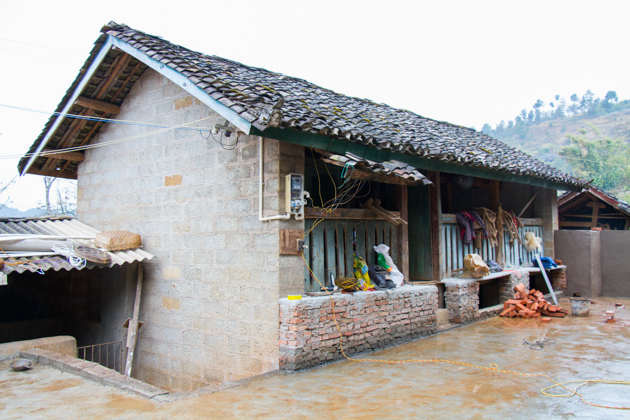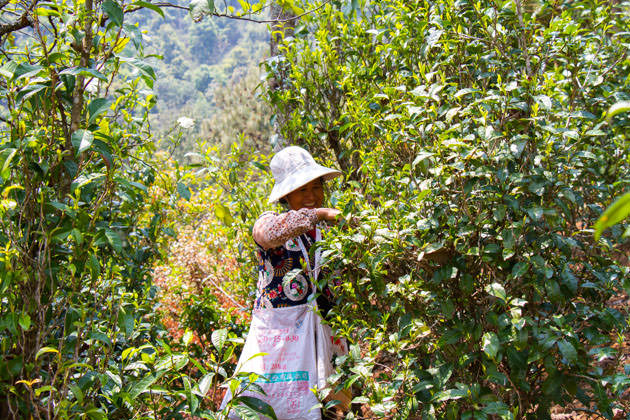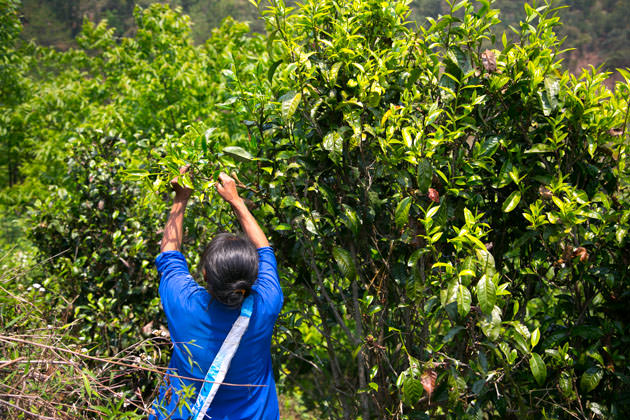- HOME >
- How to choose quality tea
The Summary of Yunnan Spring Tea 2017
As the season of the first plucking is over, I would like to share my review on 2017 teas from the South West of Yunnan, such as Lincang, Bao Shan, Jing Gu, Chang Ning and Da Li area.
Usually, the most critical factor that affects the quality of tea is weather. Since the day I came to Yunnan on 21st of March, I have been recording the weather and closely monitoring the tea quality accordingly.
- Early March〜31st March : Sunny and Cloudy
- 1st of April〜7th of April : Rain and Cloudy
- 8th of April〜14th of April:Sunny
- 14th of April〜 :Rain after Rain……..
The quality of Ming Qian(明前) tea is less attractive this year
Since the end of last year, it has been very dry weather in Yunnan. This unusual weather was not only taken place in Yunnan, but also happened in many other places in China and even Taiwan too.
Due to extremely little rain and continuous drought, the tea season delayed about 2-3 weeks. In normal year, starting from 25th of March, farmers in Lincang region start plucking tea. This year, we waited till April and we could hardly see the tea budding at the ideal garden. Those teas available before Qing Ming (清明) i.e., 4th of April, were collected from low elevation, very young tea tree or fertilized tea garden. Those teas from higher elevation, old tea tree and the naturally-farmed garden without fertilizer remained in very small bud; some trees were still dormant. As a result, tea plucked before April was not of good quality. Eventually we did not collect any tea before April, except Wild Tea that plucking season is always earlier than other tea.

Those young tea trees were available for plucking in early season.
The first week of April was raining
The rain started from 1st of April and continued for a whole week. The temperature dropped drastically and it was very cold. I had to wear the fleece jacket and run the heater when I stayed in the hotel room. Nevertheless, the rain at this timing was good news since tea trees had been suffered from drought for a long time. We assumed that it makes tea in excellent quality once the weather is sunny and temperature raise. The rain continued until 6th of April. From 7th of April, we noticed a lot of farmers effectively started tea plucking. We did not collect tea until the 9th of April. The reason is the quality of tea just after the rain is not ideal. Tea contains too high moisture and taste become thin and flavor is lighter. Those tea manufacturers who are very strict in quality will wait for two days after the rain to resume the tea plucking.


Only 30-50% of harvest
Unfortunately, the sunny weather only continues for a week. Despite people were so desperately waiting for the tea, the rain started again from 14th and continue. It was raining almost every day except certain places were sunny or cloudy on 23rd to 25th of April. Eventually raining continues until the end of April. Obviously farmers and tea manufacturers were panic due to extremely low output.
In Lincang, the production of tea is about 40-60% lower than regular year. In particular, teas from higher elevation, old tea tree and the naturally-farmed garden without fertilizer produce only 30-40% of output compared to regular year.
Due to extremely low output, the price of fresh tea leaf increases about 30-40%. For popular garden, the price increased 50% or even more.



The best quality in the past 10 years
Due to the prolonged drought, the tea trees took much longer time to grow. I noticed that the quality of tea produced in the particular one week of sunny weather was extraordinarily outstanding. Most of the skilled and experienced tea masters generally realized that teas produced in this golden one week was the best quality in a past decade or even two decades. However, the good quality teas were only produced in a short period, i.e., from 9th until 13th of April. Any teas produced earlier or later are not satisfactory due to too much rain and cloudy weather. We purchased all pu-erh teas right from the golden week except for the wild tea that are usually grown earlier.

As the weather in the latter half of April was unexpectedly bad, those well-processed teas produced in the particular golden week were extremely limited and were in high demand. They were sold out even before out from the manufacturing site in the rural village. In 2017, some people may comment that the quality is outstanding, yet some people may comment that the quality is not very good. It is all depending on the timing and the sourcing ability of each company.
Related Articles
How to get the latest update on HOJO?
1. Follow Twitter, 2. Click "Like" on Facebook, and 3. Subscribe in newsletter. You can have the latest tea news from HOJO.
 Subscribe the Newsletter to enjoy the privileges
Subscribe the Newsletter to enjoy the privileges- You may receive a free sample upon purchase, or you may have the priority to purchase special products. So please remember to subscribe our newsletter as well as the social network.
- Myanmar White Tea Bud 2013 from Guo Gan, Myanmar
- We have released a raw Pu-erh tea, 緬甸白芽茶 2013 (Myanmar White Tea Bud 2013), produced by ethnic minorities in t …
- Yong De Wild White Tea 2025 Loose Leaf Limited Release
- We have released Yong De Wild White Tea Loose 2025. For the 2025 harvest, only the loose-leaf type was …
NEW ARTICLES
 Myanmar White Tea Bud 2013 from Guo Gan, Myanmar
Myanmar White Tea Bud 2013 from Guo Gan, Myanmar- We have released a raw Pu-erh tea, 緬甸白芽茶 2013 (Myanmar White Tea Bud 2013), produced by ethnic minorities in t …
 Yong De Wild White Tea 2025 Loose Leaf Limited Release
Yong De Wild White Tea 2025 Loose Leaf Limited Release- We have released Yong De Wild White Tea Loose 2025. For the 2025 harvest, only the loose-leaf type was …
 Experience the True Freshness of Raw Pu-erh : Tang Jia 2025 Loose Leaf Release
Experience the True Freshness of Raw Pu-erh : Tang Jia 2025 Loose Leaf Release- We have released Tang Jia Raw Pu-erh Tea 唐家古樹生茶 2025 Loose Leaf. Among HOJO’s raw pu-erh teas, Tang Jia Raw Pu …
 Yunnan Chun Jian Green Tea from High Mountain Gardens
Yunnan Chun Jian Green Tea from High Mountain Gardens- Yunnan Chun Jian Green Tea is now available. This tea is made from naturally grown leaves harvested from high …
 Limited Loose Leaf Release of 2025 Da Xue Shan Wild Raw Pu-erh Tea
Limited Loose Leaf Release of 2025 Da Xue Shan Wild Raw Pu-erh Tea- We have released the 2025 loose-leaf version of Da Xue Shan Wild Raw Pu-erh Tea. This tea comes from wild tea …
 Discover a New Way to Enjoy Tea: Cooking Rice with Tea
Discover a New Way to Enjoy Tea: Cooking Rice with Tea- Cooking rice with tea is a simple idea, but it brings surprisingly satisfying results. The tea’s flavour seeps …
 2025 Da Xue Shan Wild White Tea Now Available from Yunnan
2025 Da Xue Shan Wild White Tea Now Available from Yunnan- The 2025 harvest of Da Xue Shan Wild White Tea is now available. Crafted from truly wild Camellia taliensis tr …
 Fresh 2025 Yunnan White Tea – Select Your Favourite Lot Before Blending
Fresh 2025 Yunnan White Tea – Select Your Favourite Lot Before Blending- Freshly crafted in Yunnan and just arrived in KL, our new 2025 white tea is now available at our Gardens Mall …
 2024 Dong Shan Raw Pu-erh Tea – Crafted with the Producer for Desired Quality
2024 Dong Shan Raw Pu-erh Tea – Crafted with the Producer for Desired Quality- We have released the 2024 cake of Dong Shan Raw Pu-erh Tea. Earlier, we offered the loose-leaf version from th …
 Development of Firewood Roasted Hojicha Using Naturally Grown Tea from Yunnan
Development of Firewood Roasted Hojicha Using Naturally Grown Tea from Yunnan- We are currently staying in Yunnan Province for tea production. As the season nears its end, tea trees with pa …
Category
- New Arrival at HOJO Online Shop
- Featured Articles
- Newsletter
- Types of Tea
- Origin of Tea
- Teapot and Tea Equipment
- Tea Column
- How to enjoy tea
- Tea Processing
- How to choose quality tea
- Tea constituents and functional effect
- Safety of Tea
- Foods
- Tea Business Operation
- Hobby and Outdoor Activity
- Ranking of Tea
- Video
- FAQ
- Media Release
Profile

- AKIRA HOJO
- I invite you to experience my tea selections.I was born in Nagano, Japan. In university, I studied agricultural chemistry, and I have the master degree in food science. I worked in Japanese food industry for 10 years. I involved in R&D, QC and QA. As a factory manager, I implemented ISO9000 series and managed the factory.
- The Art of Tea Magazine
- We posted the article on “The Art of Tea Magazine No.9, the magazine is published in Taiwan. We featured …
- New Straits Times
- The Malaysian National Newspaper, New Straits Times featured HOJO Tea on 17-Oct-2007.
Shop Info

Address:Lot No. T-215, 3rd Floor, The Gardens Mall, Mid Valley City, Lingkaran Syed Putra, 59200 Kuala Lumpur
Tel: +603-2287-4537
Business Hour: 10am to 10pm















